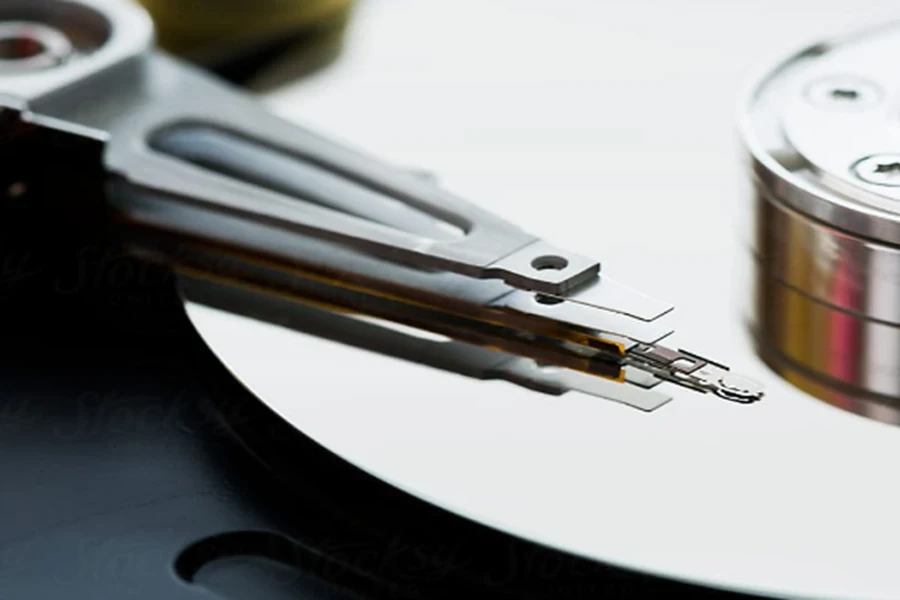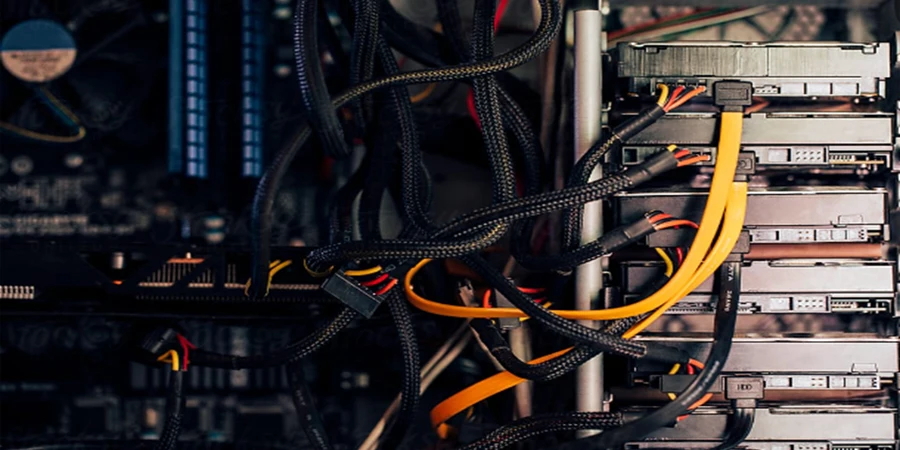Table of Contents
● Introduction
● Market overview
● Types of hard drives
● How to choose the right hard drive
● Conclusion
Introduction
Hard drives remain pivotal in today’s digital ecosystem, serving as crucial components for data storage and backup across personal and business domains. Technological advancements have significantly enhanced the capabilities of hard drives, offering a range of solutions from traditional spinning disks to robust solid-state drives. These developments cater to escalating demands for higher speed, greater durability, and larger capacity, aligning with the evolving expectations of users. As storage needs grow and diversify, understanding the spectrum of available hard drive technologies becomes essential. This foundation enables users to make informed decisions that best suit their specific storage requirements and operational environments.

Market overview
The hard drive market is currently undergoing a significant transformation, underscored by a shift from traditional HDDs to SSDs, noted for their superior speed, reliability, and lower energy consumption. According to a recent market report from Mordor Intelligence, the SSD market is expected to grow at a compound annual growth rate (CAGR) of approximately 15% from 2024 to 2029, reflecting the increasing demand for faster and more reliable storage solutions. In contrast, the market for traditional HDDs is experiencing a decline, with an anticipated CAGR of -4.87% over the same period, as more users and enterprises adopt SSDs for their primary storage needs.
Despite the decreasing costs of SSDs, which have dropped by over 20% in the past two years, HDDs continue to hold a significant share of the market, particularly for data centers and archival purposes where large volumes of data storage are required at a lower cost. According to Zakupka, the market for internal hard drives is projected to see positive growth, driven by the continuous expansion of digital data and the increasing need for large-scale, cost-effective storage solutions. The internal hard drive market is anticipated to grow steadily, driven by both the ongoing demand for higher capacity solutions and advancements in HDD technology that improve energy efficiency and data transfer speeds.

Types of hard drives
HDD (Hard Disk Drives)
HDDs, or hard disk drives, continue to be a staple in the storage market due to their capacity and cost-effectiveness. Traditional HDDs operate using spinning disks to read and write data, which, while slower than SSDs, offer a much lower cost per gigabyte. This makes HDDs particularly attractive for applications where high storage capacity is more critical than speed, such as in archival storage or secondary backup systems. According to PC Gamer, despite the advancements in solid-state technology, HDDs remain popular for users seeking large amounts of storage without the high expense associated with SSDs. Additionally, for applications requiring long-term storage where data is not frequently accessed, HDDs are highly beneficial due to their proven reliability over time. Their affordability makes them suitable for bulk data storage in business environments and for personal use where large data volumes are handled.
SSD (Solid State Drives)
SSDs, or solid-state drives, offer substantial benefits over HDDs, primarily in terms of speed and reliability. Unlike HDDs, SSDs have no moving parts, which reduces their susceptibility to physical damage and allows for faster data access. According to PCWorld, SSDs can dramatically enhance system responsiveness, with faster boot times, quicker file transfers, and lower latency than traditional hard drives. These characteristics make SSDs ideal for performance-sensitive applications, including gaming, high-speed trading, or any software environment where time is a critical factor. Furthermore, SSDs consume less power, which can be a crucial advantage in portable devices like laptops, where preserving battery life is essential. SSDs also tend to have a longer lifespan due to their lack of mechanical parts, making them a more durable option in mobile devices and high-vibration environments.
Hybrid drives and external solutions
Hybrid drives, or SSHDs, combine the technology of both HDDs and SSDs, housing a smaller SSD component for the system’s most frequently accessed data alongside a larger spinning disk for bulk storage. This arrangement allows users to benefit from improved system speed without sacrificing storage capacity or incurring the high costs of large SSDs. External hard drives, on the other hand, provide flexibility and portability, making them ideal for backups or when users need to carry their data between different locations. According to TechRadar, external SSDs have become popular for users who need fast access to their data on the go, while external HDDs remain a cost-effective solution for extensive media collections and backups that do not require frequent access. These external solutions are particularly useful for individuals and businesses looking for scalable and portable storage options that can be easily expanded or transported as needed.
Network attached storage (NAS) drives
NAS drives are specialized for use in network-attached storage systems, designed to operate 24/7 and accessible via network connections. This allows multiple users and devices to access the same storage simultaneously without requiring direct connection to the storage device. NAS drives are built for endurance, designed to handle multiple data requests efficiently, which makes them ideal for business environments or home setups where data streaming, sharing, and redundancy are priorities. They support a range of RAID configurations to ensure data redundancy and improved performance, making them suitable for critical data storage where uptime and accessibility are key. The versatility and scalability of NAS drives make them an excellent choice for growing businesses and for users with extensive media libraries.
Enterprise-class drives
Enterprise-class drives are designed for applications in data centers and servers where reliability, speed, and high data throughput are critical. These drives often come with built-in features to enhance data integrity and error correction, ensuring robust performance under continuous operation. They are built to handle higher workloads and are more resistant to vibration and heat, factors often encountered in server environments. As enterprise storage needs continue to grow with the expansion of big data analytics and cloud computing, these drives play a pivotal role in maintaining the efficiency and reliability of IT infrastructures. Enterprise drives typically offer better security features and are optimized for 24/7 operation, supporting the demanding environments of modern data centers that require minimal downtime and maximum data integrity.

Choosing the right hard drive
Storage capacity
When determining the right amount of storage capacity, users should consider both their current data usage and anticipated needs. The size of the hard drive should accommodate not only existing files but also provide room for future data accumulation. For typical users who primarily store documents, photos, and videos, a hard drive of 1TB to 2TB usually suffices. However, for professional users such as video editors or individuals who handle large-scale multimedia projects, drives with capacities of 4TB or more may be necessary due to the extensive file sizes involved. According to PC Gamer, gaming enthusiasts might also opt for larger drives to manage large game files and updates efficiently.
Performance requirements
The importance of a hard drive’s speed varies significantly depending on its intended use. For applications involving heavy data processing or real-time execution, such as gaming or video editing, SSDs are preferable due to their quick data access times. PCWorld highlights that SSDs can drastically reduce load times and enhance system responsiveness, making them ideal for performance-sensitive tasks. Conversely, for less intensive use like document editing or multimedia playback, a standard HDD may suffice, especially when budget constraints are significant.
Compatibility and connectivity
Ensuring that a new hard drive is compatible with existing systems is crucial. This includes checking the drive’s interface with the host device’s capabilities, such as whether it supports SATA or needs an adapter for USB connectivity. According to TechRadar, the type of connection can significantly affect the performance of the hard drive; for instance, USB 3.0 and Thunderbolt interfaces provide faster data transfer speeds compared to traditional USB 2.0 connections. It’s also important to consider the physical size of the drive, especially when dealing with laptops or compact desktops, to ensure it fits within the available space. Checking the file system compatibility (such as NTFS for Windows or HFS+ for Mac) is crucial to ensure seamless integration and accessibility of data across different operating systems.
Future-proofing storage
In an era where technology evolves rapidly, future-proofing storage solutions is key. Users should consider opting for hard drives with the latest technology to ensure longevity and adaptability to new software and devices. Features like encryption for security, cloud backup options, and software that enhances performance can be decisive. Moreover, with the trend moving towards 4K and even 8K video content, as suggested by PC Gamer, selecting a hard drive that can handle such high-resolution content is prudent.
Evaluating cost vs. benefit
The decision between purchasing an HDD, SSD, or hybrid drive should also involve an evaluation of cost versus benefits. While SSDs offer superior speed and reliability, they come at a higher price point. HDDs, while slower, provide a more cost-effective solution for users needing large storage capacities without the need for rapid data access. Hybrid drives present a middle ground, offering faster boot times and frequently accessed file loading speeds closer to SSDs, while still providing the high storage capacity of HDDs at a more moderate price.
Conclusion
This overview has provided a detailed examination of the diverse array of hard drive technologies available in the market, highlighting their respective advantages for different business applications. From HDDs offering economical solutions for extensive data storage requirements, to SSDs delivering superior performance for data-intensive operations, and hybrid solutions bridging the gap between capacity and speed, the array of choices supports a broad spectrum of business needs. For B2B buyers, understanding these options is crucial in making informed purchasing decisions that align with both the current operational demands and the strategic goals of scalability and efficiency. As technology continues to evolve, staying informed about these developments will ensure that investments in storage solutions are both effective and future-proof, thereby enhancing overall business resilience and technological readiness.





 Afrikaans
Afrikaans አማርኛ
አማርኛ العربية
العربية বাংলা
বাংলা Nederlands
Nederlands English
English Français
Français Deutsch
Deutsch हिन्दी
हिन्दी Bahasa Indonesia
Bahasa Indonesia Italiano
Italiano 日本語
日本語 한국어
한국어 Bahasa Melayu
Bahasa Melayu മലയാളം
മലയാളം پښتو
پښتو فارسی
فارسی Polski
Polski Português
Português Русский
Русский Español
Español Kiswahili
Kiswahili ไทย
ไทย Türkçe
Türkçe اردو
اردو Tiếng Việt
Tiếng Việt isiXhosa
isiXhosa Zulu
Zulu